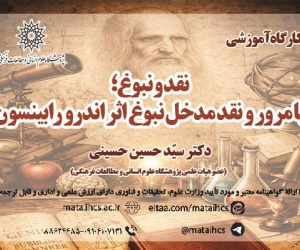The relation between the language of the Quran and science (مقاله علمی وزارت علوم)
درجه علمی: نشریه علمی (وزارت علوم)
آرشیو
چکیده
The true interdisciplinary study needs knowledge and mastery in three levels of epistemological, methodological and linguistic requisites. The linguistic level is one of the most important fundamental levels in science, which needs to be considered in interdisciplinary communication. Two major approaches about the language of the Qur’an are considered by researchers till now: philosophichermeneutics and textual. Muslim researchers are interested in the former approach and orientalists frequently incline to the latter. Although the relation between the language of the Qur’an and the language of science with text-oriented approach is less frequently taken into account. Considering the foresaid approach in this article, the author studies the differences between the language of the Qur’an and the language of science and classifies them into five categories: 1. The use of ambiguity and linguistic amphibology; 2. The use of analogy, metaphor and metonymy; 3. Holism and polysemy; 4. The application of the language of sermon and dialogue; 5. The application of verbal complexity. The use of these five linguistic features of the Qur’an is to a large extent different from their use in science. It thus causes complexity in the relation between the Qur’an and humanism on the one hand and experimental sciences on the other.نسبت زبان قرآن و زبان علم: روی آوردی تطبیقی به ویژگی های زبان قرآن و زبان علم و اهمّ تمایزهای آنها
مطالعه میان رشته ای صحیح ملازم با آگاهی و تسلط بر سه سطح از الزامات است: الزامات معرفت شناختی، روش شناختی، و زبان شناختی. ساحتِ زبانی یکی از مهمترین ساحت های علوم است که در ارتباط بیناعلومی لازم است مورد نظر قرار بگیرد. زبانِ قرآن و زبان علم نیز در زمره مهمترین بخش ها در ساحت زبانی است. تاکنون دو رویکرد عمده پیرامون زبان قرآن در میان قرآن پژوهان مورد نظر بوده است: رویکردِ فلسفی-هرمنوتیکی و رویکرد متنی. قرآن پژوهان مسلمان عمدتاً به رویکردِ اول و خاورشناسان غالبا به رویکردِ دوم تمایل داشته اند. در این میان نسبتِ زبانِ قرآن و زبانِ علم آنهم با رویکردِ متن محور کمتر مورد توجه قرار گرفته است. این پژوهش با مدّ نظر قرار دادنِ همین رویکرد به اهمّ تمایزات زبان قرآن با زبان علم پرداخته و این تمایزات را در قالب 5 قسمت مورد نظر قرار داده است: 1- کاربستِ ابهام و ایهامِ زبانی؛ 2- کاربستِ تشبیه، استعاره، و مجاز؛ 3- کل نگری و چندمعنایی؛ 4- کاربستِ زبانِ خطابه و دیالوگ؛ و 5- کاربستِ تعقید لفظی. کاربستِ این 5 زبان در قرآن تمایز واضحی با علم دارد و همین امر نیز موجب می شود ارتباط قرآن با علوم انسانی و تجربی بسیار پیچیده گردد.
زبان قرآن ،زبان علم ،ابهام و ایهام ،کل نگری و چند معنایی ،خطابه و دیالوگ ،تعقید لفظی،









